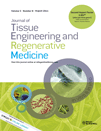Phenotypic differences during the osteogenic differentiation of single cell-derived clones isolated from human lipoaspirates
Abstract
Osteogenic precursors can be obtained from mesenchymal stem cells, which can be isolated from different sources, including adipose tissue. Optimal osteogenic differentiation in in vitro conditions and the selection of the potential precursors that could be further used in bone regeneration still have two main questions left to solve, viz. the heterogeneity of the mesenchymal cell population and the presence of a basal transcription level of several characteristic genes of the osteogenic lineage, which makes rapid and effective comparisons during cell differentiation difficult. Single-cell clones were isolated and expanded from human lipoaspirate cells. Osteogenic differentiation was induced and studied in defined media, using four representative isolated cell clones showing differences in the basal expression of a set of characteristic osteogenic genes. The clones showing a low constitutive expression of these genes were able to display comparatively higher levels of mineralization. In addition, the cells from these clones displayed a characteristic pattern of bundle fibres of collagen during osteogenic induction and showed a higher potency to differentiate towards the adipogenic lineage. These results demonstrate that specific multipotent precursors can be isolated from human lipoaspirate cells with a higher differentiation potential, allowing the maturation of specific lineages in a shorter time. These results additionally demonstrate that, since the basal expressions of the several genes were used as osteogenic markers, a phenotypic biochemical analysis should always be utilized to study optimal osteogenesis conditions. Copyright © 2010 John Wiley & Sons, Ltd.





